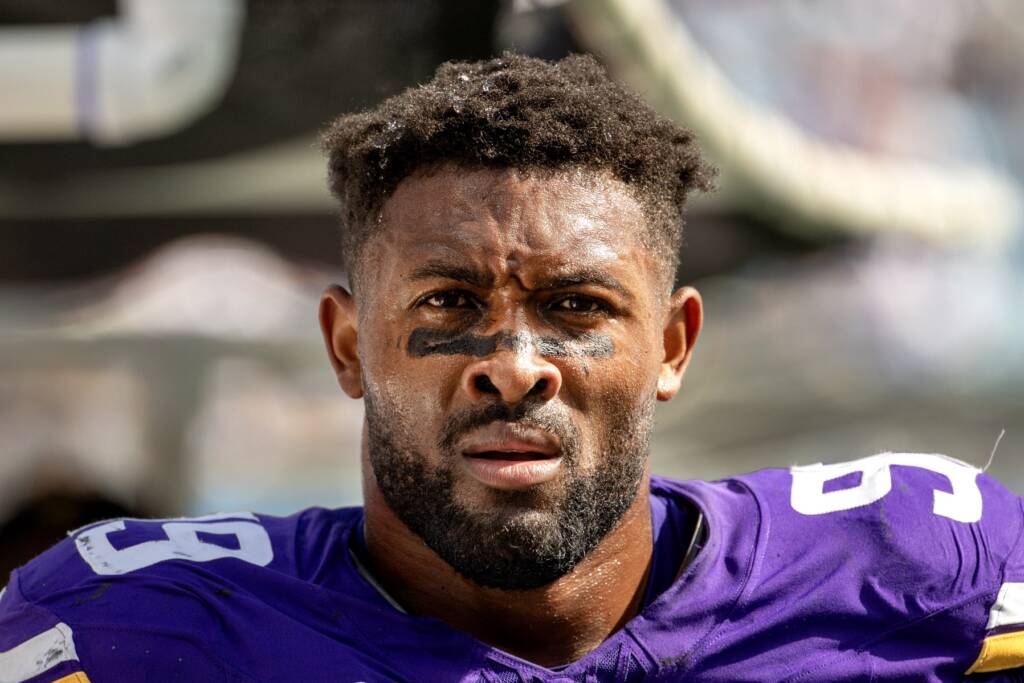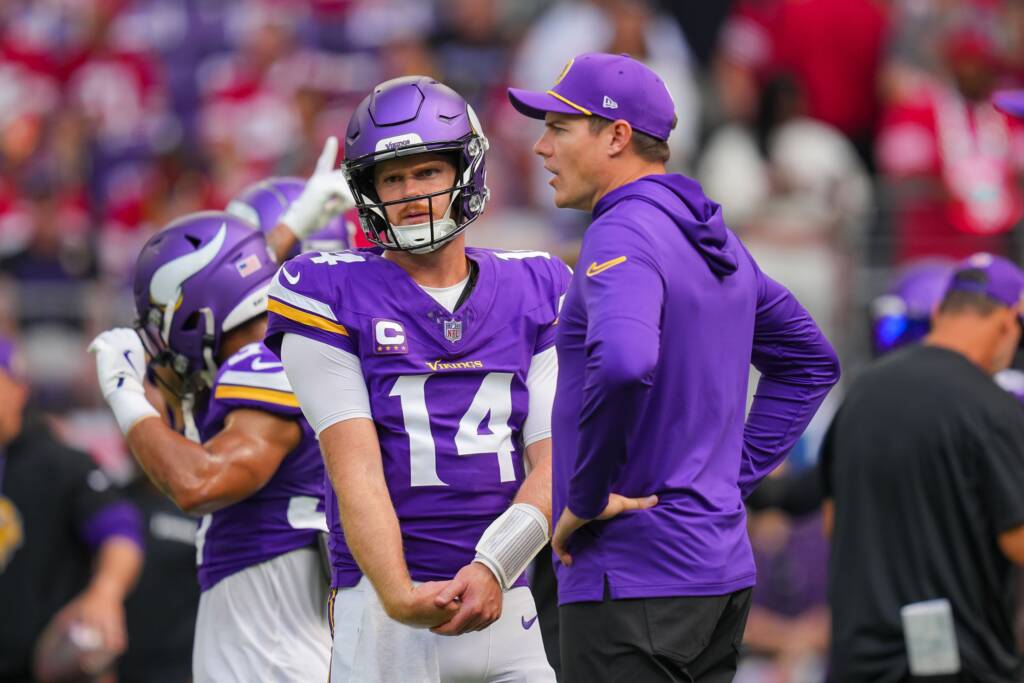After a short hold-in during training camp, the Minnesota Vikings amended Danielle Hunter‘s contract this offseason to increase his pay this year from $5.5 million guaranteed to $17 million guaranteed with incentives up to $20 million.
The additional money was a long time coming for the former third-round pick who signed a long-term deal before he ascended to becoming one of the best players in the NFL. Getting Hunter back in the fold was always key for Minnesota’s defense in 2023. The team swapped out Za’Darius Smith for Marcus Davenport, but it didn’t add any other players through the draft to bolster the depth at the position.
Through six games of the 2023 season, Hunter has clearly been worth the extra money the Vikings spent on him. His 8.0 sacks are tied for the league lead (note: T.J. Watt, who Hunter is tied with, has only played five games). Hunter leads the league with 11 TFLs, and also has 10 run stops, per PFF, which is tied for seventh in the NFL.
The tape backs up Hunter’s production. He’s been excellent in both phases of the game. Let’s take a look to see how he’s playing so far.
Pass rush
Hunter has perhaps the most unique pass rush moveset in the NFL because of his athleticism. His signature move, described by OL/DL guru Brandon Thorn as an underhook/pull-through, is one that only he uses, and he deploys it to great effect:
Hunter compliments this rush move with counters off of it, including an effective spin move, like on the below, where he beats Carolina Panthers RT Taylor Moton:
Brian Flores’ defense has also been beneficial to Hunter. It has allowed him to change up his rush angles by aligning him in different positions and stunting. Per PFF, Hunter as aligned in the A gap, B gap, or directly over the opposing tackle 24 times this year, vastly outstripping his 14 total snaps in those positions in all of 2022. That allows him to use his athleticism against slower interior players, like on the below rep where he forces a holding call against the opposing C:
Blitzing has also given Hunter advantageous matchups. Here, with Hunter lined over the tackle, the Chicago Bears choose to kick the protection out and block him with an RB, a grave mistake. Hunter drives the RB back in the QB’s lap, and distrupts Justin Fields pass, which turns into an INT:
This idea also got Hunter a strip sack against the Los Angeles Chargers, when they tried to block him with Josh Kelley.
Stunts have also allowed Hunter to get production this season, like the below flush stunt to get him a wide open lane up the middle towards Patrick Mahomes:
Interestingly, outside of the sacks, Hunter’s pressure numbers do not impress from either PFF charting or ESPN’s Pass Rush Win Rate. Despite many clear wins on tape, I have a feeling that there are two major reasons these are not adding up to what is seen on tape. The first is that the Vikings are blitzing an absurd amount of the time. At a 54% blitz rate, Minnesota is blitzing 12% more than the New York Giants, who are second in that category.
While the blitzes the Vikings run have helped Hunter in some situations outlined above, Minnesota’s main blitz, Bengal Hawk, does not. That blitz is designed to get the end man on the line of scrimmage a free rush at the QB. That player is usually a DB, and almost never going to be Hunter, who opposing offenses key on and make sure to block. If Hunter does get a free rush, you can bet that the ball is coming out quickly, and he won’t get to log a pressure.
Below is an example of the Vikings using Hawk to get Harrison Smith a free rush. Hunter is never going to get a pressure on this type of play, because he is there to contain if the QB somehow escapes:
Like on the play above, the Vikings’ high blitz rate has forced their opponents to get the ball out at an incredibly quick pace. Per PFF, Patrick Mahomes averaged getting the ball out in 2.3 seconds when he was blitzed. Bryce Young averaged 2.24 seconds, Justin Herbert 2.19 seconds, and Baker Mayfield 2.37 seconds. For context, Kirk Cousins‘ average time to throw against the blitz this season is 2.51 seconds, and he holds onto the ball for over 2.5 seconds on 41% of his dropbacks.
Jalen Hurts and Chicago’s combination of Justin Fields and Tyson Bagent held onto the ball for significantly longer, but were heavily punished for it. Hunter recorded five of his sacks across those two games, and the Vikings as a team recorded nine total sacks, three INTs, and one forced fumble in those two games.
Because the Vikings blitz so often, and QBs have responded by getting the ball out against zone coverage behind those blitzes, Hunter has a lot of pass rush opportunities that are dead on arrival, where he is not in a situation that he can get a pressure. I’m willing to bet this rate is a lot higher than other players at his position around the league, and help explain Hunter’s low pressure numbers despite excellent sack numbers and tape.
run defense
In addition to his pass rush prowess, Hunter is a high level run defender. On the play below, he collapses a block from an opposing TE to help get in on the tackle:
Hunter has another defeat of a TE on the play below, making a TFL on the RB:
Hunter’s great athleticism also helps him in the run game. On the play below, he is able to chase down the RB while being the unblocked defender on outside zone. Offenses leave players in Hunter’s position unblocked specifically because they don’t think they can make this type of play:
athleticism and effort
The sideline-to-sideline athleticism above shows up consistently from Hunter, and is part of his total package as a player. High level effort is an important trait for the game’s best players, and Hunter has it in spades. You can regularly find him chasing down plays behind him, like on this screen:
This extends to when Hunter goes up against the game’s best. Fields may not be the complete package as a QB, but he is certainly an elite athlete at the position. On the play below, Hunter is able to chase him down for the tackle on a scramble just a yard or two past the line of scrimmage, despite Fields having a head start. That type of athleticism is rare:
That athleticism also showed up against Chicago’s option game. On the play below, Hunter takes a wide path in order to contain Fields on a potential read option play. Fields hands the ball off, but Hunter is quick enough to get back to the RB and make a tackle before he gets to the second level. For most players, the RB will get completely past them and the defense will have to rely on the secondary to make the tackle. Not with Hunter:
conclusion
After getting a raise before the season, Hunter has lived up to his modified contract for the Vikings through six weeks. Hunter uses his signature pass rush move to get wins as a rusher, and is a complete mismatch when opponents try to block him with a TE or RB. In the run game, Hunter plays assignment sound defense and has the power to maintain his gap and make sound plays. Hunter is an elite athlete who regularly uses that athleticism to chase down plays from behind, which shows great motor from a player of his caliber.
Hunter has proven his worth this year, but his contract is still set to expire. Turning 29 in a couple of weeks, Hunter still has multiple high level seasons ahead of him before a decline might hit. The Vikings would be wise to look at retaining Hunter this offseason as a key piece of the defensive line moving forward.

